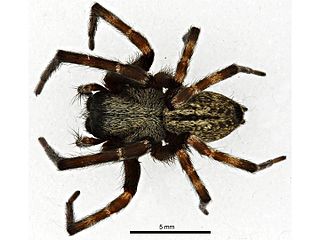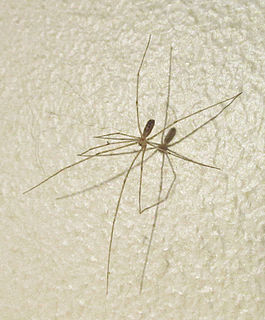
Huntsman spiders, members of the family Sparassidae, are known by this name because of their speed and mode of hunting. They are also called giant crab spiders because of their size and appearance. Larger species sometimes are referred to as wood spiders, because of their preference for woody places. In southern Africa the genus Palystes are known as rain spiders or lizard-eating spiders. Commonly they are confused with baboon spiders from the Mygalomorphae infraorder, which are not closely related.

The Pholcidae are a family of araneomorph spiders. The family contains over 1,800 pholcids, including those commonly known as the marbled cellar spider , daddy long-legs spider, granddaddy long-legs spider, carpenter spider, daddy long-legger, vibrating spider, gyrating spider, long daddy, and skull spider. The family, first described by Carl Ludwig Koch in 1850, is divided into 94 genera.

Scaffold web spiders (Nesticidae) is a family of araneomorph spiders closely allied with tangle web spiders. Like the "Theridiidae", these spiders have a comb of serrated bristles on the hind tarsi that are used to pull silk bands from the spinnerets. It contains 16 genera and about 300 species, many of which are associated with caves or overhangs. The genus Nesticus is the type for the family and is found throughout the world. The related Eidmannella has speciated considerably in Texas caves and includes some extremely localized species that are considered threatened. One species, Eidmannella pallida, is found in caves and under overhangs, but also in agricultural fields and other habitats away from such restricted areas. The genus Carpathonesticus is found in central Eurasia.

The black house spider or common black spider is a common species of cribellate Australian spider, introduced to New Zealand and Japan. A closely related species, Badumna longinqua, the grey house spider, has a similar distribution, but has also been introduced to the Americas.

Diaea is a genus of crab spiders first described by Tamerlan Thorell in 1869. Most species are found in specific locations except for D. livens, which occurs both in the United States and D. dorsata, which has a palearctic distribution. Adults are 5 millimetres (0.20 in) to 7 millimetres (0.28 in) and tend to hide in and around vegetation, especially flowers, where their color allows them to blend in to their surroundings.

Missulena occatoria, known as the red-headed mouse spider, is found in Southern Australia, from open forest to desert shrubland. It is the largest and most widely distributed Missulena species, because the spiderlings are wind-dispersed (ballooning). Normally this only occurs with araneomorph spiders, mygalomorph spiders normally disperse by walking. Missulena venom may be very toxic, but few cases of serious envenomation have been recorded. Most recorded bites only caused minor effects, with Australian funnel-web spider antivenom having proved effective as a treatment.

Badumna is a genus of intertidal spiders that was first described by Tamerlan Thorell in 1890. They are harmless spiders that can be found around human structures and buildings. They are darkly colored, usually with a lighter colored pattern on the abdomen. The most well-known species is B. insignis, also known as the "black house spider" or "black window spider".
Missulena insignis, commonly known as the lesser red-headed mouse spider, is a species of spider belonging to the family Actinopodidae native to Australia. The species name is derived from the Latin insignis "mark".
Macarophaeus is a genus of European ground spiders that was first described by J. Wunderlich in 2011. As of May 2019 it contains only three species: M. cultior, M. insignis, and M. varius.
Cornifalx is a monotypic genus of Tasmanian araneomorph spiders in the family Orsolobidae containing the single species, Cornifalx insignis. It was first described by V. V. Hickman in 1979, and is only found in Tasmania.

Helophora is a genus of dwarf spiders that was first described by Anton Menge in 1866.

Badumna longinqua or the grey house spider is a species of spiders in the family Desidae. Native to eastern Australia, it has been introduced into New Zealand, Japan, the United States, Mexico, and Uruguay.
Baryphyma trifrons is a species of dwarf spider in the family Linyphiidae. It is found in North America, Europe, the Caucasus, and in a range from Russian Europe to the Far East).

Psilochorus simoni is a species of cellar spider in the family Pholcidae. It is found in the United States, has been introduced into Europe, Turkey, and New Zealand.
Laphria insignis is a species of robber flies in the family Asilidae.
Pelegrina insignis is a species of jumping spider in the family Salticidae. It is found in the United States and Canada.
Helophora reducta is a species of sheetweb spider in the family Linyphiidae. It is found in the United States.
Calotarsa insignis is a species of flat-footed flies.
Dysticheus insignis is a species of broad-nosed weevil in the beetle family Curculionidae. It is found in North America.
Amara insignis is a species of seed-eating ground beetle in the family Carabidae. It is found in North America.










